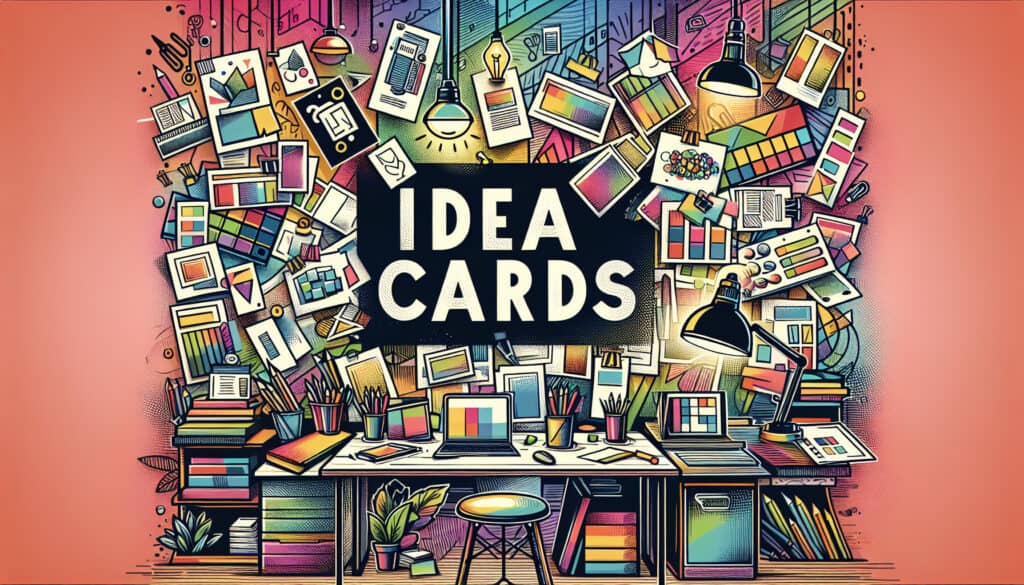To capture and share ideas in a simple and standardized format.
- Methodologies: Engineering, Product Design, Project Management
Idea Cards

Idea Cards
- Brainstorming, Continuous Improvement, Creativity, Design Thinking, Ideation, Interaction Design, Prototyping, Teamwork, User-Centered Design
Objective:
How it’s used:
- Small cards that are used to write down ideas during a brainstorming session or ideation workshop. They typically have a pre-defined format, such as a title, a description, and a sketch, which helps to ensure that ideas are captured in a clear and consistent way.
Pros
- Simple and easy to use; Encourages participation and helps to organize ideas.
Cons
- Can be difficult to manage and synthesize a large number of cards; May not be suitable for complex ideas.
Categories:
- Ideation
Best for:
- Capturing and organizing ideas in a brainstorming session or workshop.
Idea Cards can be effectively utilized across various stages of product development, particularly during the ideation phase of design thinking workshops, where collaboration among cross-functional teams is imperative. They facilitate not only the generation but also the categorization and prioritization of concepts, making them valuable tools in sectors such as consumer electronics, automotive design, healthcare innovation, and even software development. In these environments, participants such as product managers, designers, engineers, and marketing specialists collaborate to refine ideas further, assessing their feasibility and market potential. This method encourages diverse contributions, as each participant can write down their thoughts independently and share them with the group, which nurtures a culture of innovation while minimizing the intimidation that may come from more open discussion formats. For example, in a healthcare design workshop, stakeholders might utilize Idea Cards to address patient experience improvements, sketching solutions for care delivery challenges or ways to enhance user interface design in medical devices. The simplicity and structure provided by Idea Cards ensures that all contributions are documented uniformly, making it easier to refer back to these ideas later in the design process, such as during prototyping or testing phases, ultimately driving toward more informed decision-making.
Key steps of this methodology
- Define the prompts or challenges that will guide the idea generation.
- Provide each participant with a set number of Idea Cards.
- Encourage participants to write down their ideas on the cards, including a title, description, and sketch.
- Set a time limit for idea generation to keep the session focused.
- Instruct participants to share their cards with the group, explaining each idea briefly.
- Facilitate a discussion on the ideas, allowing for clarifications and questions.
- Categorize similar ideas together to identify themes and patterns.
- Select the most promising ideas for further development through consensus or voting.
- Iterate on the selected ideas, refining details and potential applications on new Idea Cards.
Pro Tips
- Incorporate a multi-dimension approach by categorizing cards into themes or challenges during brainstorming to enhance focus and track patterns.
- Implement time constraints for idea development on cards to encourage concise thinking and drive rapid innovation.
- Rotate cards among team members periodically to allow for diverse input, enabling cross-pollination of ideas and expanded perspectives.
To read and compare several methodologies, we recommend the
> Extensive Methodologies Repository <
together with the 400+ other methodologies.
Your comments on this methodology or additional info are welcome on the comment section below ↓ , so as any engineering-related ideas or links.
Historical Context
1949
1950
1950
1960
1960
1960
1960
1940
1950
1950
1958
1960
1960
1960
1960
(if date is unknown or not relevant, e.g. "fluid mechanics", a rounded estimation of its notable emergence is provided)















Related Posts
Musculoskeletal Discomfort Questionnaires
Multivariate Testing (MVT)
Multiple Regression Analysis
Motion Capture Systems
MoSCoW Method
Mood’s Median Test